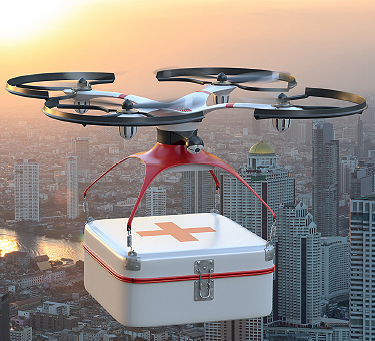Take to the skies
Drones behind the scenes – the as-yet-unseen benefits. By Rohit Gupta
For some years now, drone technology has been billed as the next big thing. For many, the main associations which spring to mind when thinking about the technology are their uses in military defense, surveillance, awe-inspiring landscape photography and wedding videos. Elsewhere, we have seen them wreak havoc at Gatwick and Heathrow airports.
Despite these incidents, drones have huge potential for businesses across many industries, including retail, logistics and healthcare. In fact, it was recently predicted that commercial drones will have an annual impact of $31 billion to $46 billion on GDP in the US alone by 2026. The technology also presents many societal benefits such as reducing crime and saving lives.
The ability of drones to offer these benefits is due to the technology’s ability to capture data from its surroundings and to process this to inform actions. Whether autonomous or supervised, drones have evolved now to have both great range and precision, able to collect a constant stream of various data depending on what sensors are integrated. The application of artificial intelligence (AI) to these data streams will only improve the value of drones.
Here, we explore some of the less obvious benefits the technology can bring to various industries and how to tackle the issue of trust.
- Reducing human risk: The surveillance potential of drones can really come into its own when it comes to reducing human risk. The range and agility of the technology, combined with its increasing affordability, allows drones to access and assess areas that would otherwise pose huge potential danger. For example, in the aftermath of a natural disaster or explosion when searching for missing or injured people, or to support in the inspection of tall structures or remote oil rigs. The technology can allow teams to conduct rigorous search and rescue or make repairs as quickly and safely, without putting human life in unnecessary danger.
- Reaching all corners of the world: One of the main criticisms of delivery by drone technology, is that it is unlikely to catch on because the existing infrastructure, already meets consumers’ needs. However, there are places where they can be essential. In remote areas that are cut off from reliable regular transport networks, the delivery of medicine for example, can be relatively cheap, and improve and even save lives. Communities without road, rail or air links, either permanently or as a temporary result of conflict or natural disasters such as a hurricane or earthquake, can also rely on drones for the fast delivery of essentials, including food packages and medicine.
- The future farmer: Many farms in countries like the US and Australia are too big for a single person, or even a team of people, to manage the entire area of land. Previously, some of the largest farms have depended on the use of small planes to get access to certain areas of farmland, which are expensive to run. Drones offer a cost-effective alternative The technology can also be used to treat crops with on-board sprays with great precision enabling entire fields to be treated far more quickly than with traditional machinery. This level of data collection and analysis is beyond even the largest teams of people. Drones allow for quicker and continuous assessment of vast spaces, both indoors and outdoors, and ultimately will drive improvements in agricultural processes and efficiencies by applying this data analysis to ongoing operations.
- Keeping in touch: Another example of how the technology can benefit society and solve a recurring problem of providing temporary structures, such a festivals, pop-up venues or emergency shelters with network coverage and Wi-Fi, is through adding telecoms equipment to drones. It works by essentially functioning as a short-term hotspot for that location. This same use can be applied in areas where the power has gone down following a natural disaster or outage, reconnecting communities in an emergency and again assisting in locating individuals.
Putting trust in drones
It was recently found that only 23 per cent of UK adults support deliveries by drone because of the risks associated with it, whether it is about their deliveries being dropped, drones stolen or delivery drivers losing their jobs. Negative stories, whilst rare, do have an impact on the general perception of drone technology, and therefore organizations need to be cognizant of the speed at which they deploy them.
However, the benefits drones can provide in certain circumstances can be substantial, leveraging their prodigious data-capture abilities and allying these with AI-driven analysis to give valuable insights and drive better decisions. As the technology continues to improve in accuracy and ability and organizations refine how the technology can be used to solve complex problems, they will provide increasing value to society and industry. Whilst the sci-fi film imagery of our skies buzzing with drones will for the moment at least remain a fantasy, what is clear is that drone technology will continue to play a vital role both now and in the years to come.
Rohit Gupta is Head of Products and Resources, Europe, at Cognizant. Cognizant is one of the world’s leading professional services companies, transforming clients’ business, operating and technology models for the digital era. Its unique industry-based, consultative approach helps clients envision, build and run more innovative and efficient businesses. Headquartered in the US, Cognizant is ranked 194 on the Fortune 500 and is consistently listed among the most admired companies in the world.
www.cognizant.com